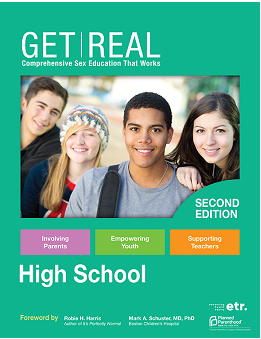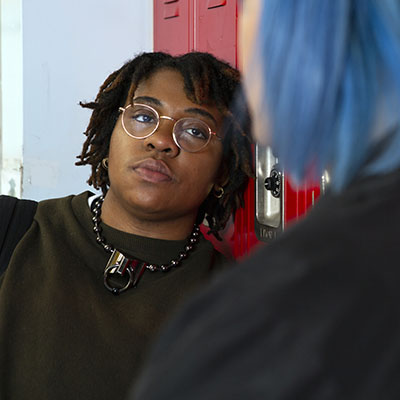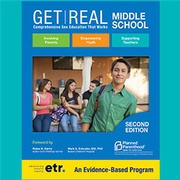Best Practices of Sex Education in Get Real 2nd Edition
By Teagan Drawbridge-Quealy, MEd & MSW | April 4, 2019
Get Real Trainer, Planned Parenthood League of MA
Here in the Northeast, it feels like winter might just be fading. Spring is coming, and with spring, the end of the school year is just around the corner. For many educators the start of spring also means the start of sex education in their health classes, coinciding with the changing of seasons. Maybe there is something to the “birds and the bees” after all!
As sexuality and health educators begin preparing for their sex education lessons, trainers at Planned Parenthood League of Massachusetts’ (PPLM) Get Real and Professional Training Institute want to remind educators of three best practices when it comes to delivering sex education. The best practices highlighted below have been incorporated into the 2nd Edition of Get Real: Comprehensive Sex Education That Works, which has officially hit the shelves at ETR!
Get Real: Comprehensive Sex Education That Works, 2nd Edition
Now in a new, 2nd edition! Get Real: Comprehensive Sex Education That Works is a curriculum for middle and high school students developed by Planned Parenthood League of Massachusetts and published by ETR. It promotes abstinence from sex as a healthy and safe choice for adolescents; provides a comprehensive understanding of sexual health, sexuality and protection methods; and supports parents and other caring adults as the primary sexuality educators of their children. Get Real is developmentally appropriate, inclusive of LGBTQ+ youth, trauma informed, and aligned to the National Health Education Standards using the CDC's Health Education Curriculum Analysis Tool. Learn more here.
Utilizing a Trauma-Informed Lens
It’s impossible to know the experiences of every student who comes into our classrooms. So instead of trying to guess, we must be prepared and assume that some students will have experienced trauma in some way in their lives.
This trauma may include sexual violence or abuse. As sexuality educators, our job is to create a safe learning environment for all our students; and when it comes to the topic of sexuality, there can be a lot of triggers—things that come up in the lessons we teach that bring up these past experiences.

Get Real now has Teacher’s Notes on the cover page of many lessons to give educators the language needed to allow students the right to self-care. Alerting a school counselor ahead of these lessons can also be helpful, in case students disclose traumatic experiences and seek support from the counselors.
Sometimes educators feel resistant about teaching sex education because they worry that students will act “silly” or “out of control.” It’s important to remember that trauma shows itself in a variety of ways. Some students may disengage with the material. Others may act out. Still others may share their experiences with you.
All of these behaviors are common responses to trauma. So, remember, just because a student is “acting out” doesn’t mean they don’t want to be there. It may mean that this content is bringing up a lot of emotions for them, and they are having a hard time processing it.
As their educator, you can reinforce your role as a caring adult in their lives by checking in with them, not forcing them to participate, and letting students know you are a safe adult and they can always talk to you.
Being trauma-informed isn’t about going “an extra step.” Rather, it’s an essential step in creating a safe environment for all students. Being trauma-informed goes hand in hand with building Social Emotional Learning (SEL) Skills, a foundation of Get Real. Providing opportunities to build empathy, self-management, self-awareness, social awareness, responsible decision making, and healthy relationships skills are all groundwork for being trauma-informed.
In fact, we know that building these SEL skills can affect students’ academic success, emotional regulation and overall behavior in a positive way. What’s more, social emotional learning skills, combined with comprehensive, trauma-informed sex education, constitute primary prevention of sexual assault and harassment (see here, for example). These foundational skills are ones that students will utilize throughout their lives.
Changing How We Talk about Consent
There has been a lot of coverage about consent in the media lately, from the #MeToo Movement, to discussions around affirmative consent at the university level. We know this topic must be discussed in the sex education classroom. We cannot talk about relationships and communication without also discussing boundaries and consent.
 And yet, traditionally the focus of consent in sex education curricula has been on how to say “no.” As adults begin to have more open, honest conversations about what consent is and how to make decisions regarding sexual behavior, it’s important that we provide students with the skills needed to navigate these conversations as well.
And yet, traditionally the focus of consent in sex education curricula has been on how to say “no.” As adults begin to have more open, honest conversations about what consent is and how to make decisions regarding sexual behavior, it’s important that we provide students with the skills needed to navigate these conversations as well.
Building skills around consent means moving beyond the “how to say no” model of teaching refusal skills to also teach young people how to ask for consent and how to respect a partner’s boundary when they say “no” to something. This isn’t easy! Even as adults we may have a hard time hearing “no” to something we want. Hearing and respecting a “no” truly is a skill that must be taught.
That’s why we are so excited that the 2nd Edition of Get Real has newly integrated talking points around consent. These move beyond teaching students to practice saying “no,” to providing students with opportunities to discuss why it’s difficult to hear “no” and what they can do to show a partner they respect their boundary. The 2nd Edition also includes Get Real’s definition of sexual consent as “requiring a sober ‘yes’ from all partners, free from intimidation or pressure. Consent is an on-going process, and a ‘yes’ to something once, doesn’t mean a ‘yes’ to something always.”
Teaching consent is also a crucial part of being trauma-informed. It is important for all young people to know that they have the right to own their own bodies—to make choices about their bodies and decide what their boundaries are. This understanding is especially important for youth who have experienced sexual violence.
Intentional and Inclusive Language
Two prime tenets of the Get Real Approach are (1) communicating openly and honestly, and (2) creating an inclusive and learner-focused environment. One way to be open, honest and inclusive is by removing unnecessary gendered language from anatomy and puberty lessons. The Get Real and Professional Training Institute has been working hard to understand and practice the best ways to teach and train on these lessons without using binary terminology like “male” and “female.” We know this work is important, and we want to do it well. Our 2nd Edition was reviewed by staff at Cardea for LGBTQ+ inclusivity and trauma-informed language. Nearly every lesson has had edits made to it to be more inclusive and trauma-informed.
 Additionally, we know that representation matters. Yet LGBTQ+ youth are still left out of sex education classes and conversations about sexuality. Classes are still taught in a heteronormative and cis-normative frame.
Additionally, we know that representation matters. Yet LGBTQ+ youth are still left out of sex education classes and conversations about sexuality. Classes are still taught in a heteronormative and cis-normative frame.
When educators discuss sexual behavior or relationships, many consistently use language such as “boyfriend or girlfriend,” and assume that students are only engaging in romantic/sexual relationships with a partner of another sex. Part of being inclusive and intentional is actively working to remove that language from our teaching. The Get Real 2nd Edition includes updated Gender and Sexual Identity Lessons that have included feedback from Get Real Educators and LGBTQ+ youth across the country.
Being inclusive and intentional goes beyond LGBTQ+ inclusiveness. We recognize that historically, sex education curricula have often stigmatized and shamed certain populations, such as pregnant and parenting teens. Often curricula will discuss pregnancy as a “consequence” of sex. For our students who have experienced a pregnancy or are parenting, that’s a value-laden word that carries a lot of judgment.
When piloting a version of our Get Real High School curriculum with pregnant and parenting young people, we received feedback around how some of the language landed for them. We are thrilled that our 2nd Edition incorporates small shifts in language to honor their feedback. Shifting language from “should” to “could” and “consequence” to “risk” can make all the difference in how a statement or information is perceived and experienced by our students. Ultimately, that can make the all the difference in their engagement with the material and what they take from our lessons.
As sexuality educators we have a wonderful opportunity to share information with young people, and engage them in open, honest conversations about relationships, consent, decision-making and so much more. To truly engage in those conversations, we must be intentional, inclusive and trauma-informed. We are so excited that the 2nd Edition of Get Real incorporates each of these best practices throughout all the lessons of the middle school and high school curricula!
Teagan Drawbridge-Quealy, MEd & MSW, is the Get Real trainer at Planned Parenthood League of Massachusetts and a member of ETR’s training cadre. She can be reached at tdrawbridge@pplm.org.
Images from The Gender Spectrum Collection.




